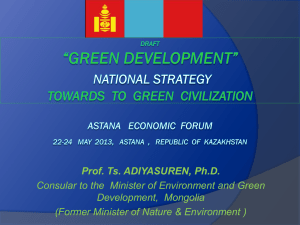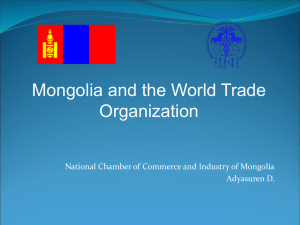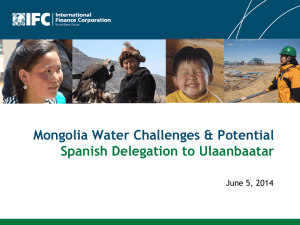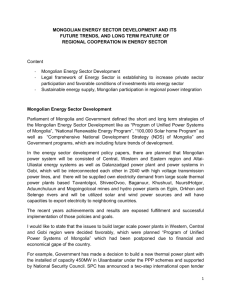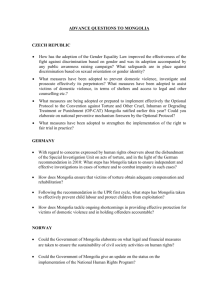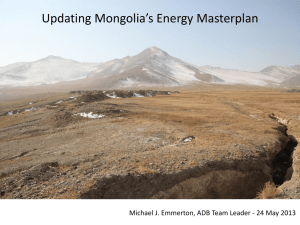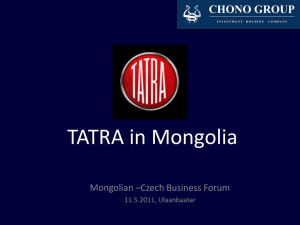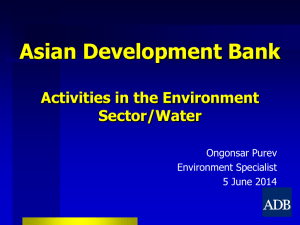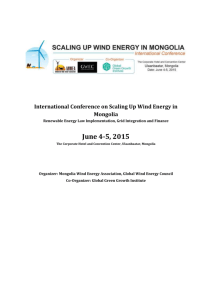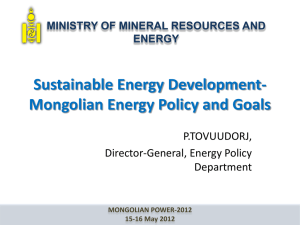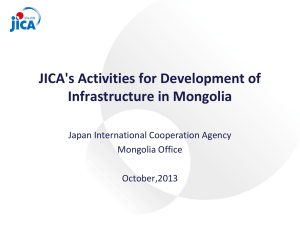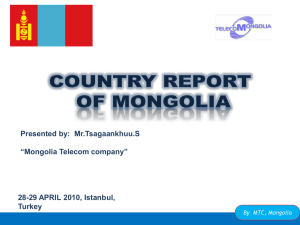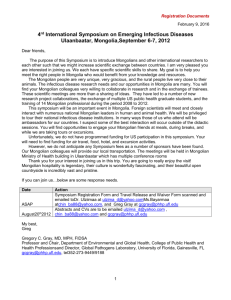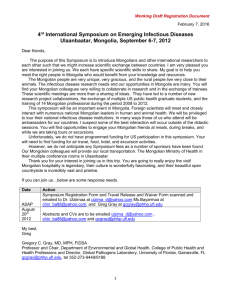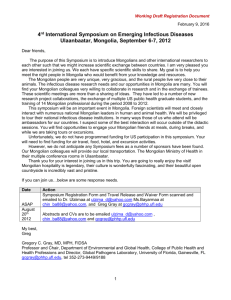THE CURRENT STATE OF ENERGY SECTOR IN MONGOLIA
advertisement
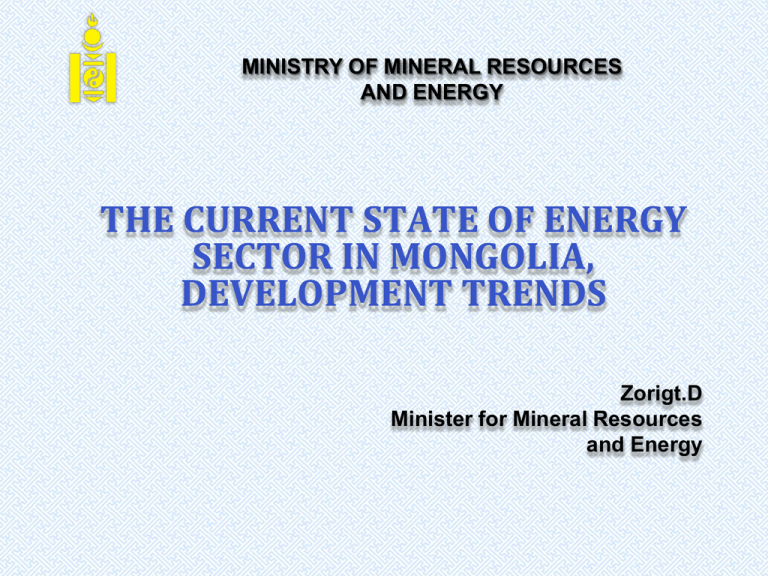
MINISTRY OF MINERAL RESOURCES AND ENERGY THE CURRENT STATE OF ENERGY SECTOR IN MONGOLIA, DEVELOPMENT TRENDS Zorigt.D Minister for Mineral Resources and Energy Agenda Ministry of Mineral Resources and Energy THE CURRENT STATE OF ENERGY SECTOR THE SECTORAL DEVELOPMENT PROGRAMS AND POLICY DOCUMENTS AND THEIR IMPLEMENTATION POLICY AND OBJECTIVES OF THE SECTORAL DEVELOPMENT SHORT TERM STRATEGY AND GOALS 2 ЭРДЭС БАЯЛАГ, ЭРЧИМ ХҮЧНИЙ ЯАМ The energy sector of Mongolia consist of four independent electric power systems: The current state of the energy sector Central Energy System (CES), Western Energy System (WES), Eastern Energy System, Altai-Uliastai energy system in addition to Dalanzadgad combined heat and power plant (CHP) and other diesel fuel and renewable energy sources. Energy sector of Mongolia is working sustainably with continuous and secure energy supply. ЭРДЭС БАЯЛАГ, ЭРЧИМ ХҮЧНИЙ ЯАМ Hydro power, 31 Diesel fuel stations, 13.2 The current state of the energy sector Solar and wind, 0.6 Imported, 214.1 Thermal power , 4256.1 According to the results of the Central, Western and Eastern energy systems of 2010, the total energy production of thermal power plants reached 4,256.1 million kWh, 31 million kWh from hydro-electric stations, 0.6 million kWh from solar and wind power stations 13.2 million kWh from diesel fuel stations, 214.1 million kWh of energy were imported, 20.7 million kWh of energy were exported. Energy supplied to customers from these networks totaled to 3648,4 million kWh of electricity 6,474 thousand Gcal of heat. ЭРДЭС БАЯЛАГ, ЭРЧИМ ХҮЧНИЙ ЯАМ The current state of the energy sector The total revenue of big energy companies resulted in MNT 280,5 billion, MNT 66,3 billion for taxation and duties paid to state and local budgets. In 2010, the amount of receivables from consumers and suppliers amounted to MNT25.4 billion, and accounts payable amounted to MNT29.3 billion, showing a decrease of 17.5% and 44.5% from 2009 respectively. Between 2008 and 2010, MNT 105,5 billion were invested into mineral resources and energy sector from the Mongolia Development Fund. Between 1990 and 2008, the energy sector received USD575.3 million of grant and loans from foreign countries, international banks and financial institutions, of which USD347.9 million were loans and USD 227.4 million were grant. Through these grants and loans, 67 project programs were successfully implemented, and some are still ongoing. 5 ЭРДЭС БАЯЛАГ, ЭРЧИМ ХҮЧНИЙ ЯАМ The sectoral development programs and policy documents and its implementation The State Great Khural and the Government of Mongolia approved a “Program on Integrated Energy System of Mongolia”, “the National Program on Renewable Energy” and the 100 000 Solar Ger’s Program in addition to “the Comprehensive Policy on National Development” and Government programs include concrete short-term and long-term strategies for the development of the energy sector. The sectoral development programs and policy documents and its implementation ЭРДЭС БАЯЛАГ, ЭРЧИМ ХҮЧНИЙ ЯАМ Implementation of the Program on Integrated Energy System of Mongolia: Currently, all 21 aimags and 318 soums are supplied by centralized energy source while 15 soums are supplied from renewable sources and other hybrid systems. The first phase or short-term (from 2007 to 2012) action plan of “the Program on Integrated Energy System of Mongolia” is currently being implemented successfully. Implementation of “the 100,000 Sun Lights” and “the National Program on Renewable Energy”: Currently, use of renewable energy sources for power generation has become a reality as a result of which about 100,000 nomadic families and 15 soums have access to electricity using a renewable energy sources. “100,000 Sun Lights” national program will be completed in 2011 with the final distribution of 20,000 solar home system. 8 Policy and objectives of the sectoral development ЭРДЭС БАЯЛАГ, ЭРЧИМ ХҮЧНИЙ ЯАМ If to assess energy sector according to its developmental phases, the period between 2000 and 2008 was a time of electrification where structural changes into the energy sector was made, state policy on providing electricity were implemented, all aimags and soums in the countryside were connected to electricity and nomads were provided with small scale renewable energy sources. Period from 2008 to 2011 became a time when equipment and technologies were upgraded and renovated and when preparatory works for supplying sources to regional electricity systems went underway. The period between 2011 and 2016 can be seen as a beginning of new development era in which large scale energy supply networks and main power lines will be built to establish an Integrated Energy System which will meet the country’s ever-growing energy demand. 9 ЭРДЭС БАЯЛАГ, ЭРЧИМ ХҮЧНИЙ ЯАМ In 2011 updates and amendments will be made to legal framework and main policy documents: Policy and objectives of the sectoral development “Law of Mongolian on Energy” “Integrated Energy System of Mongolia” National programme, “Master plan of Energy sector” The following results expected in the future: Study • Realistic energy consumption growth trend and demand supply based on research analysis and calculations Policy and planning • More specific and detailed plans to supply increasing energy demand precisely aligned with the new trends in the Mongolian social and economic development Implementation • Well studied, attractive to the investors and internationally acceptable projects and action plans 10 Short term strategy and goals According to the following studies conducted on large industrialized and settlement regions and cities it can be estimated that between 2015 and 2030, the country’s energy consumption rate will reach 1,500 to 3,000MW. Power consumption prognosis by 2020 based on the General Plan of Ulaanbaatar city Development; power demand prognosis study of the central energy system of Mongolia and the Gobi mining zone, conducted from Asian Development Bank’s consulting company on Ulaanbaatar CHP-5 project’s technical study; energy supply required to heat ger district households of Ulaanbaatar city with electric heaters within the framework of Law on Air Pollution Reduction; energy consumption data of industrialized regions by “Worley Parsons” company; technical and economic feasibility study on the Energy Supply to the Mining Consumers of the Gobi Region 11 ЭРДЭС БАЯЛАГ, ЭРЧИМ ХҮЧНИЙ ЯАМ Short term strategy and goals The government’s policy and legal environment are favorable in supporting the public-private sector cooperation and investment and In order to meet Mongolia’s energy consumption growth for 2015- 2030 and to export electricity, it is necessary to build power stations near mining deposits such as •Ulaanbaatar CHP-5 •Aduunchuluun, •Тavan tolgoi, •Hotgor, •Shivee ovoo, •Booroljuut, •Baganuur, •Chandgana •And other thermal plants on the coal deposits •Big capacity hydropower, wind parks, and solar systems The initiatives, active participation and support from international banks, financial institutions, foreign and domestic investors, and business entrepreneurs of the energy sector, are of vital importance for the best implementation of these projects. 12 Short term strategy and goals ЭРДЭС БАЯЛАГ, ЭРЧИМ ХҮЧНИЙ ЯАМ In the near future, Mongolia’s Ministry will implement the following principles and strategies towards the development of the energy sector, including: Conducting a well-grounded estimate and revision of energy consumption rate, and drafting an action plan based on these data; Providing financial and economic opportunities to build new sources of energy supply networks and developing energy sector; Supporting the construction of new energy supply networks by the private sector, developing the legal environment of energy prices and tariffs, and developing a public-private sector partnership; Developing and expanding power line networks under the review of the Government in accordance with the consumption and energy supply sources projections; Increasing the efficiency of the energy sector, providing its financial sustainability, implementing economically feasible regulations, and fully transferring the energy sector and prices to market regulations. 13 Thank you for the attention! 14

